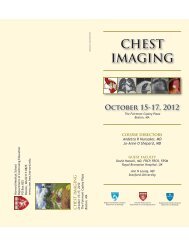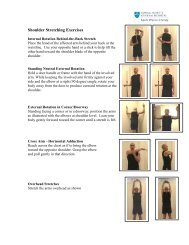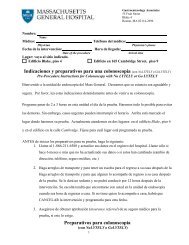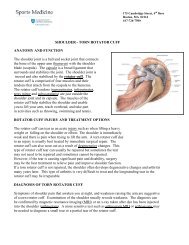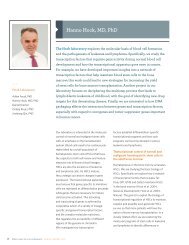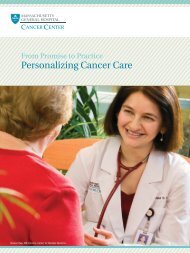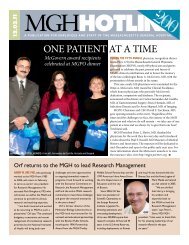Run to Home Base has new finish line - Massachusetts General ...
Run to Home Base has new finish line - Massachusetts General ...
Run to Home Base has new finish line - Massachusetts General ...
You also want an ePaper? Increase the reach of your titles
YUMPU automatically turns print PDFs into web optimized ePapers that Google loves.
03.05.10<br />
– Cooper<br />
(Continued from page 1)<br />
Patient Care Services staff specialist; and Karen Miguel, RN, patient safety officer<br />
for MGH Imaging. The group will discuss the MGH’s role in shaping the course of<br />
patient safety internally, nationally and internationally.<br />
Cooper is internationally renowned in the anesthesia community for his<br />
seminal contributions <strong>to</strong> the prevention of adverse events and patient injury and<br />
is considered a pioneer in the development of medical simulation. His studies<br />
of human error in medicine in the 1970s were among the first ever conducted.<br />
Cooper retired last April as the direc<strong>to</strong>r of Biomedical Engineering of Partners<br />
HealthCare, having served in this role for 14 years.<br />
The following brief dialogue with Cooper is a preview of the March 11 event.<br />
Q: Your contributions <strong>to</strong> patient safety are recognized nationally and internationally.<br />
How did you start down this path of focusing on and making major contributions <strong>to</strong><br />
patient safety?<br />
A: When I arrived at the MGH in the ‘70s there was no such thing as “patient<br />
safety.” Human error was hardly mentioned openly. I was a biomedical<br />
engineer in the Department of Anesthesia. Our team studied errors in<br />
anesthesia and how they happened. We listened carefully <strong>to</strong> clinicians about<br />
their s<strong>to</strong>ries of error and interpreted those in<strong>to</strong> ways <strong>to</strong> make anesthesia<br />
safer. Those lessons led me <strong>to</strong> help create the Anesthesia Patient Safety<br />
Foundation (APSF) in 1985. That was the first organization in the world<br />
that focused solely on patient safety. Some years later, research that APSF<br />
supported led me <strong>to</strong> see the value of simulation training for patient safety.<br />
Q: What <strong>has</strong> been of significant influence and meaning <strong>to</strong> you during your journey as a<br />
patient safety expert?<br />
A. Although I am a biomedical engineer, my work is really not primarily about<br />
technology, it’s about people, especially about how they work <strong>to</strong>gether. The<br />
MGH was a fertile environment for people like me. I had freedom <strong>to</strong> explore<br />
<strong>new</strong> ideas. Ironically, while it can be challenging <strong>to</strong> get <strong>new</strong> ideas accepted in<strong>to</strong><br />
practice, it’s still a great place <strong>to</strong> conceive them and try them out. I was lucky<br />
<strong>to</strong> have great men<strong>to</strong>rs and colleagues, particularly in Ron Newbower, PhD, who<br />
is currently chief technology officer for CIMIT. Richard J. Kitz, MD, the<br />
Department of Anesthesia chief for 20 years, created the kind of environment<br />
that nurtured interdisciplinary collaboration. He formed the Bioengineering<br />
Unit in Anesthesia and enabled engineers like me <strong>to</strong> work closely with clinicians<br />
<strong>to</strong> see how things really worked, especially in the operating rooms. Whatever<br />
success is attributed <strong>to</strong> me is more appropriately due <strong>to</strong> our collaborative,<br />
supportive and synergistic interdisciplinary team. That wouldn’t have<br />
happened without the environment created by their support and protection.<br />
Q: You are one of the pioneers in health care simulation. What is medical simulation<br />
training, and how <strong>has</strong> it encouraged a culture change in health care?<br />
A: Simulation is about practicing without putting patients at risk. At the Center<br />
for Medical Simulation, which is another example of MGH’s enabling of<br />
innovation, we work <strong>to</strong> get people <strong>to</strong> be more self-reflective, <strong>to</strong> think more<br />
deeply about how they make mistakes, how accidents happen and how<br />
they can prevent them. By using simulated clinical situations for training on<br />
teamwork and managing emergencies, we are teaching caregivers how <strong>to</strong><br />
avoid crises and develop better teamwork skills. We’re working <strong>to</strong>ward a<br />
fundamental culture change – that people don’t practice on patients until they<br />
really know what they are doing first. While I have a broad focus in patient<br />
safety, simulation for teamwork and learning without putting patients at risk<br />
<strong>has</strong> become my main interest.<br />
©DON wEST<br />
COMMUNITY COLLABORATION: From left, Edward Davis, Bos<strong>to</strong>n Police<br />
commissioner; Ayanna Pressley, Bos<strong>to</strong>n City councilor-at-large; and Slavin<br />
Community anti-drug<br />
efforts move eastward<br />
in a recenT door-To-door survey conducted by the Bos<strong>to</strong>n<br />
Public Health Commission (BPHC), more than 80.7 percent of<br />
East Bos<strong>to</strong>n residents expressed concern about drug use among<br />
youth in their community, while 66.4 percent expressed concern<br />
about adult substance abuse. With this in mind, the BPHC,<br />
Mayor Thomas M. Menino and other state and city officials<br />
hosted a Community Summit on Substance Abuse Feb. 13 at<br />
the Harborside Community Center in East Bos<strong>to</strong>n <strong>to</strong> release the<br />
survey’s findings and launch a reenergized anti-drug effort in<br />
the neighborhood.<br />
The summit featured the announcement of the city’s<br />
collaboration with Partners HealthCare and the MGH in the<br />
development of substance abuse prevention programs. Partners<br />
<strong>has</strong> committed $75,000 <strong>to</strong> support the anti-drug initiative, and<br />
city officials plan <strong>to</strong> work <strong>to</strong> develop programming with the MGH<br />
Center for Community Health Improvement, which <strong>has</strong> helped<br />
create very successful substance abuse prevention coalitions in<br />
Charles<strong>to</strong>wn and Revere. Peter L. Slavin, MD, MGH president,<br />
and Gary L. Gottlieb, MD, MBA, Partners HealthCare president<br />
and CEO, were on hand at the event <strong>to</strong> express their support.<br />
“We are extremely pleased <strong>to</strong> work with East Bos<strong>to</strong>n, the<br />
Mayor, the Bos<strong>to</strong>n Public Health Commission and the East<br />
Bos<strong>to</strong>n No Drugs Coalition <strong>to</strong> address the community substance<br />
abuse problem,” said Slavin in his remarks. “This is very<br />
challenging, often frustrating but also rewarding work because it’s<br />
really about building a more resilient community.”<br />
Half of the Partners funding will be dedicated <strong>to</strong> the creation of<br />
a youth education campaign on the dangers of prescription drugs.<br />
The remaining funds will support other efforts deemed necessary<br />
by the East Bos<strong>to</strong>n community and may include community<br />
meetings; an adult education campaign; an in-depth look in<strong>to</strong><br />
policies and procedures related <strong>to</strong> prescription medications; and<br />
increasing available activities and jobs for youth. n



